You're currently on:

Buchla Easel V
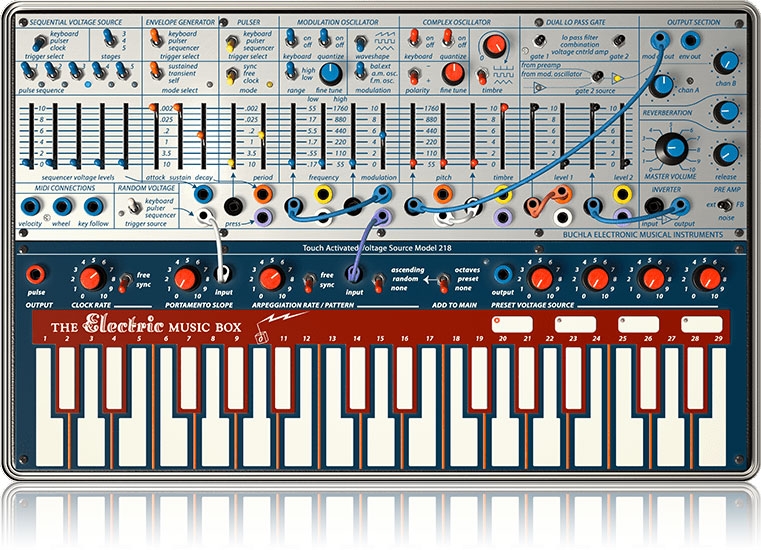
One look at the Buchla Easel V and you know this is a different beast. In fact, it makes you think differently about sound right from the start—and the soundscapes you can design with it are as unique as the front panel array. To put that experience at your fingertips, we meticulously recreated the rare 1973 Buchla Music Easel right down to the component level. As you’ve come to expect from our other V-series instruments, we’ve gone the extra mile by designing in an enhanced feature set including polyphony, innovative new modulation/control sources, step sequencer, effects, and more.
If you like to paint outside the lines, Buchla Easel V is the perfect artistic tool for you.
Main Features
A component-level model of the Buchla Music Easel
Complex and Modulation oscillators, dual Low Pass Gates, output section with spring reverb modelling
Modulation sources perfecly reproduced : 5-step Sequencer, Envelope Generator, Pulser
Semi-modular architecture, color-coded routing and cables
Enhanced functionalities, synchronizable Pulser and Clock, Oscillators quantization
Left Hand modulation sources to create multi-point envelopes and LFOs. Add randomness and smoothing to the modulation
Right Hand step-sequencer module
Gravity XY modulation source. Control the sound with the movement of a projectile flying among planets and worm holes!
10 effects, Phaser, Flanger, Chorus, Overdrive, Delay, ...
Control on the Vactrol modelling for fast, medium or slow response
Up to 4 voices of polyphony
256 factory presets
Welcome to West Coast school of synthesis
Your music breaks from the pack. So does the Buchla Easel V.
The Buchla Easel V faithfully reproduces Buchla’s Music Easel that helped define West Coast synthesis’ focus on experimentation and breaking musical norms. We’ve applied our award-winning TAE™ modeling technology from the front panel to the resistors to capture it all with incredible realism.
Complex oscillator design, AM and FM synthesis, uniquely percussive gate/filter combos, and numerous ways to modulate and clock just about every parameter, all drop you right in the middle of a sonic sandbox. Design and perform soundscapes that burble, shimmer, pulse and evolve without ever touching a keyboard or pad—unless you want to add even more control. Nearly 300 presets by expert sound designers get you started with timbres ranging from hauntingly beautiful sonorities to clangorous pokes in the ear.
Whether you’re looking to experiment with simple sounds or build complex evolving passages, the Buchla Easel V is a constant source of inspiration for sonic adventurers.

Create sounds no one has ever heard before
In addition to faithfully reproducing a classic, we’ve infused the Buchla Easel V with even more of that vintage goodness to love.
We’ve made patching even more fun and foolproof. When you drag a color-coded patchcord between patch points, only valid targets light up, saving you the frustration of making invalid connections that do nothing. The original Music Easel lacked a noise source, so we’ve added one to the preamp—handy for introducing rhythmic elements. We’ve also designed a feedback loop into the preamp, so you can really get things howling. Up to four-voice polyphony greatly enhances your performance capabilities, too.*
With our extensions to Buchla’s original design, you now have an even more intuitive programming experience paired with additional sonic options.
* Note that while our extreme modeling at the component level on the Buchla Easel V delivers insanely great analog sound, each voice of polyphony requires significant processing power to pull it off—approximately 20 percent of an i7 CPU per voice.

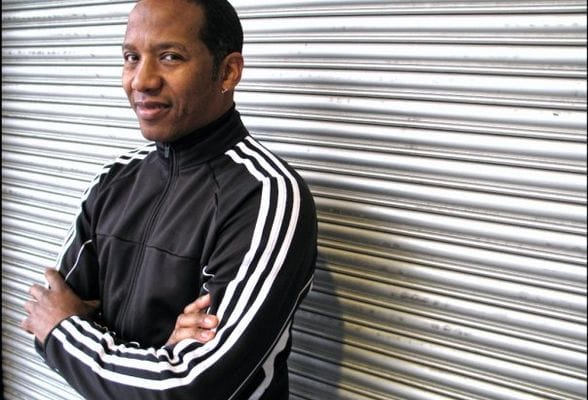
 Artists Corner
Artists Corner
The Buchla is so much fun to use. Just an amazing sounding replica!Paul Frazier
( Arrested Development, St. Vincent, Chaka Khan )
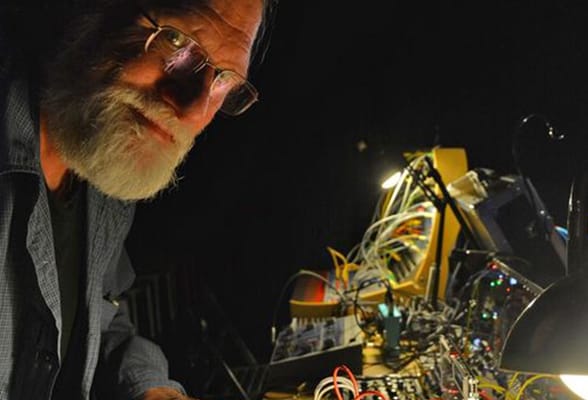
 Artists Corner
Artists Corner
All the features of the Easel are thoughtfully and accessibly implemented. The additional on board sonic sculpting tools (fx, extra function generator, 32 step polyphonic sequencer..) made this an all-in-one power house. Buchla Easel V brings on the fun of sonic exploration!Todd Barton
( Composer / Sound Designer )
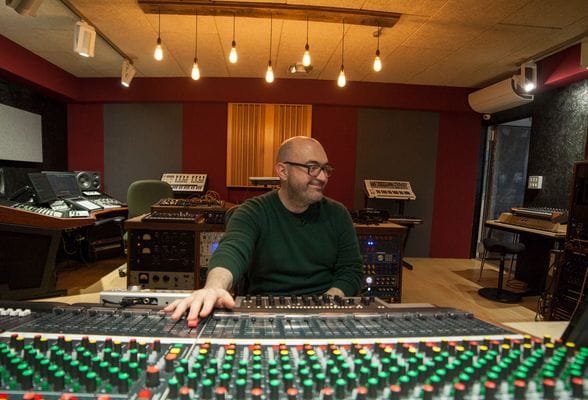
 Artists Corner
Artists Corner
I love it!Paul Godfrey
( Morcheeba )
Arturia Software Center

ASC is the central software that elegantly manages all your Arturia software licenses. It activates your licenses and synchronizes them across multiple devices (you get five instances with each instrument license). ASC also notifies you of updates and downloads them. You can even easily learn about new products, download demos versions and purchase the full products. Simple.
Included in V Collection
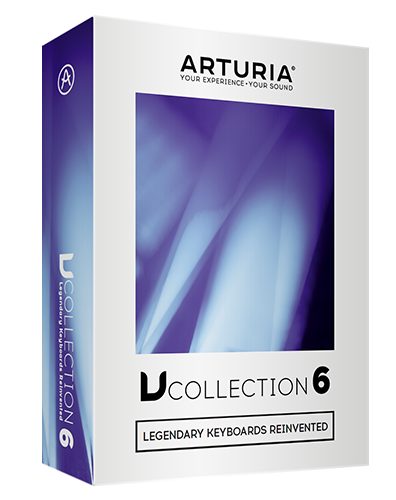
This instrument is also part of the V Collection 6 -your complete dream line-up of the legendary synths, organs, pianos and more that made keyboard history. They’re modeled with the most advanced technologies for authentic realism, and enhanced with new creative options. Whether you use it as DAW plugins in the studio or standalone at gigs, V Collection 6 puts the greatest keys of all time at your fingertips for instant inspiration.
TAE® Powered
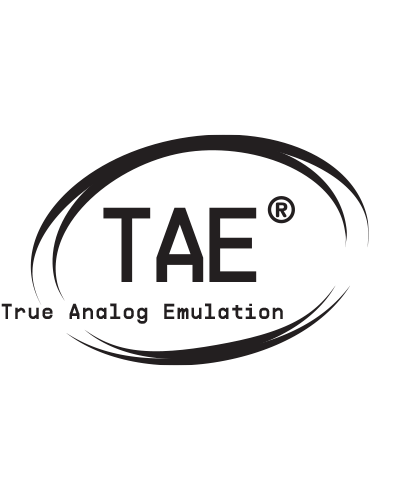
TAE® "True Analog Emulation" is Arturia's exclusive technology that accurately reproduces the defining sonic qualities of analog synthesizers. It recreates the characteristics of analog oscillators in amazing detail, transparency and clarity, as well as the exact properties of the analog filters that give each classic instrument its unique sound. Soft clipping adds even more punch and presence. TAE® is primarily what makes our virtual instruments indistinguishable from the originals.
 Gallery
Gallery
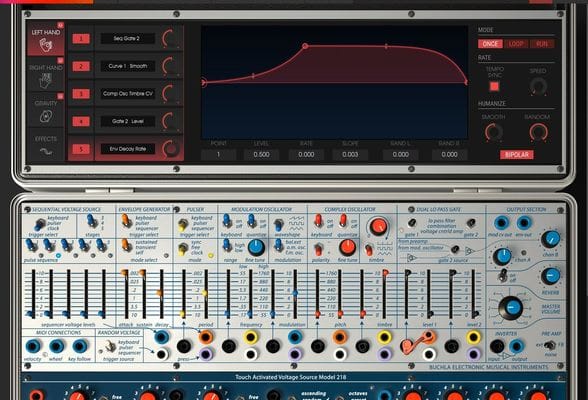
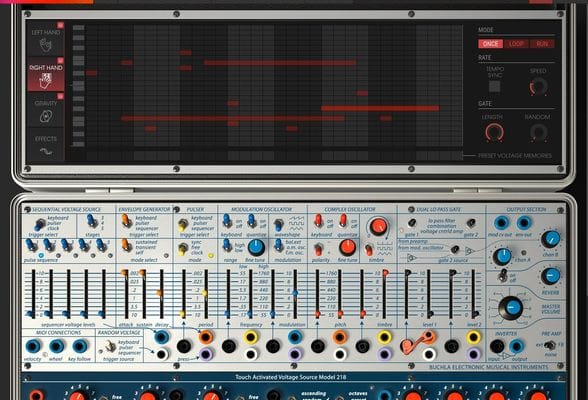
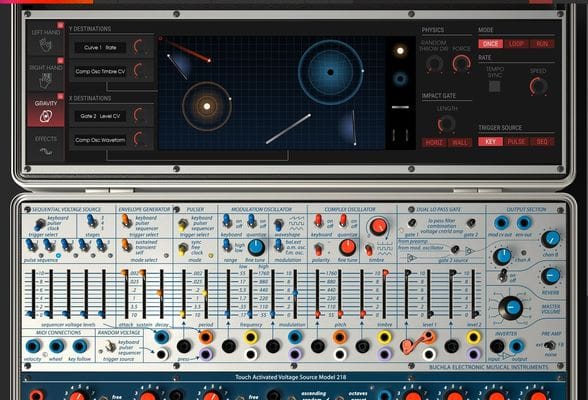

Conjuring some West Coast magic
Don Buchla is credited along with contemporary Bob Moog as one of the fathers of synthesis.
He got his start in 1963 when experimental composers Morton Subotnik and Ramon Sender at the San Francisco Tape Music Center commissioned him to build a voltage-controlled instrument—one that would take their music beyond the capabilities of static sound sources and processors relying exclusively on manual control. Buchla’s implementation took the form of a series of independent modules connected via patch cords to define one of first modular systems. Subotnik went on to use Buchla’s designs for his seminal “Silver Apples of the Moon” LP, the first electronic music LP commissioned by a record company. Buffy Saint-Marie’s 1969 “Illuminations” album featured the same instrument.
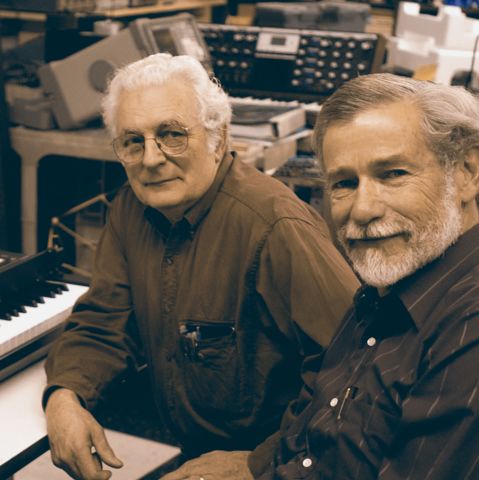
Working independently 3000 miles apart, Buchla and Moog were very different men with diverging design philosophies. Where New England-based Moog was more methodical, Buchla’s penchant for bucking the system in both his personal life and electronic designs reflected his immersion in the ‘60s cultural revolution emanating from his Bay Area home. Ultimately, their differing approaches came to be emblematic of “East Coast” versus “West Coast” synthesis—although some of those lines are more blurred today.

Buchla didn’t like calling his designs synthesizers because he felt the term inferred imitating familiar sounds rather than working completely outside the box. The most telling difference is Buchla’s early refusal to incorporate a traditional music keyboard because he knew it would confine the unfettered sonic explorations he wanted to engender. When he finally did implement a semblance of a keyboard, it was in the form of stationary touch plates that output different voltages depending on how much of a finger was in contact with the surface and where—decidedly a different type of touch sensitivity.

In 1973, Buchla distilled his modular design into a portable briefcase format called the Music Easel. It was semi-modular, with essential hardwired connections augmented by patch points concentrated in a common area—making for less wiring spaghetti. It included what would become signature West Coast features like additive/modulation-focused synthesis, integral sequencer and clock triggering, separate non-triggered oscillator gain controls, filter/gate combos and more. While history shows that Buchla’s designs were never mainstream, that was exactly the entire point from a creative standpoint.
Timeless, original, and inspiring, the Easel will forever be a joyous source of avant-garde sonic exploration.
Unique sound generation à la Buchla
Get your hands on an authentic replica of the definitive sound sources and signal processing that brought a different perspective to the world of analog synthesis.
1. Modulation Oscillator
The Modulation Oscillator is hardwired to modulate the Complex Oscillator, optionally patchable to other targets. You can set it for amplitude modulation (AM), frequency modulation (FM), or to AM-modulate an external signal like another track on your DAW. In low-frequency range, AM and FM produce effects like tremolo, vibrato, and trills. In audio range, they create distinctive sidebands that reshape the main sound source—anything from subtle harmonics to otherworldly ring modulation. Audio range also gives you the option of using the Modulation Oscillator as a second sound source, complete with it’s own timbre, pitch, and voltage inputs.
2. Complex Oscillator
Buchla Easel V’s main sound generator is the Complex Oscillator. Its core waveform is a sine wave to which you add harmonics through wave folding—a type of wave shaping (also found in Arturia’s Brute hardware synth series) where the peak of a wave is cut off and folded back onto itself. The number of folds determines the harmonic content. You can induce further harmonics by crossfading that with a square, triangle or sawtooth wave. The Complex Oscillator can either be under melodic keyboard control or fixed in pitch for rhythmic elements, drones and more. Pitch and timbre can be modulated.
3. Dual Low Pass Gates
Easel V features two low-pass gates—essentially 12 db/octave voltage-controlled filters (VCFs) configured to behave like gates, in that the closed state is actually just a sub-sonic cutoff frequency. This is yet another contributor to the instrument’s unique sound. You can switch each gate’s mode between filter, gate, or combination. Gate 1 is hardwired to the Complex Oscillator. You can switch Gate 2 to process the preamp’s output, Modulation Oscillator, or Complex Oscillator. In the latter case, the two gates operate serially for some unique effects.

4. Vactrols
Buchla’s gate design employs vactrols—optically coupled LEDs and light-sensitive resistors—exhibiting organic attack and decay properties ideal for imitating tuned percussion. No two vactrols behave identically. We’ve modeled these individual components, and even given you control over their response characteristics in our commitment to complete faithful reproduction of this iconic sound.
5. Preamp
We’ve upgraded the preamp to give you more creative options. The new feedback option loops the output back into itself, making it possible to introduce overdriven analog resonances. Where the original instrument lacked a noise generator, we’ve added one to the Easel V that you can use as a source for percussive sounds, dirty atmospheres, and more.
Buchla Easel V faithfully recreates the original instrument’s unique sonic architecture, giving you access to the stuff of legends.
Monster modulation
Buchla Easel V delivers a cornucopia of unique modulation methods that let you shape new sounds and bring driving motion to your music.
Many of Easel V’s modulation modules have options to determine how they respond to triggers from your keyboard and/or each other, giving you complex transients and motion with flexible performance control. For example, you can decide if you want to trigger the Sequential Voltage Source via the Pulser or vice versa—each exhibiting dramatically different results.
1. Envelope Generator
The Easel V’s ASR Envelope Generator features switchable operating modes. In Sustained mode, the sustain portion has a minimal duration that can be extended as long as a note is held. In sustained mode, the envelope completes regardless of whether the key is briefly hit or durably held—handy for percussion patches. Self mode—added to later hardware incarnations of the Music Easel—causes the envelope to repeat endlessly, resulting in cyclic effects more complex than you can realize with LFOs. You can also set the envelope to be triggered by the Pulser or Sequential Voltage Source, providing you with a variety of unique methods of realizing sonic animations.
2. Pulser and Sequential Voltage Source
The Pulser provides a straightforward source for simple or repeated triggers that you can route a number of places, including options for free running, clock sync, and more. It’s an easy way to create something like metronomically repeated gating. For more capability, the Sequential Voltage Source outputs three to five programmable voltage steps you can collectively route to modulate various targets—pitch for melodic variations, modulation amount for timbral changes, amplitude for a series of gain steps, and more.
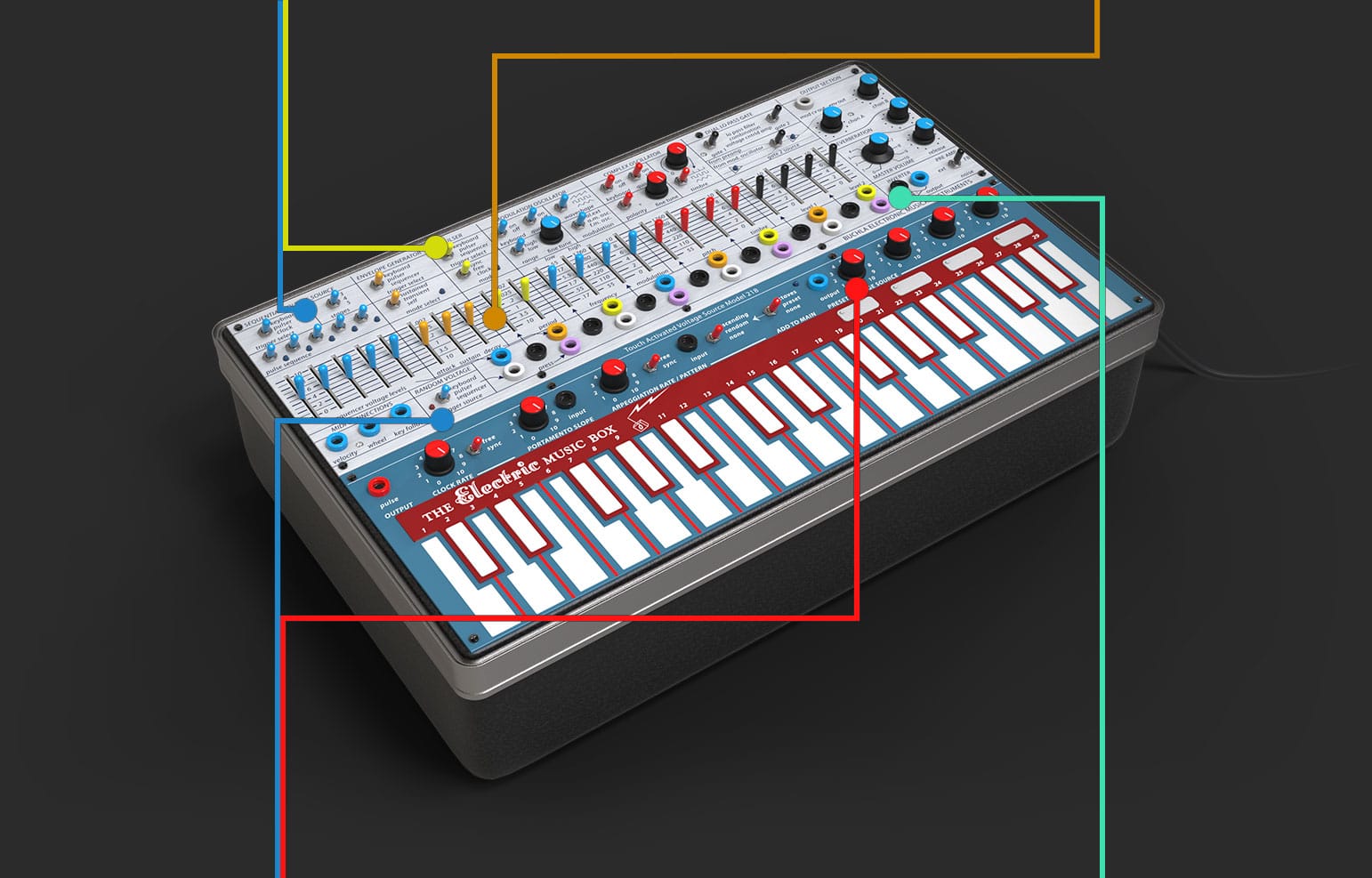
3. Additional Modulation
The Random Voltage Generator is great for generating unpredictable voltages, including presenting different values simultaneously on each of its patchbay outputs. The Preset Voltage Source outputs one of four voltages according to the value you set for the associated pad—handy for performance functions like predictable transposition offsets. You’ll love driving the Easel V from external audio, such as using a DAW drum track to trigger parameters you connect to the Envelope Out of the built-in envelope follower. You’ll also find plenty of other patchable goodies, including clock pulse, voltage inverter, and MIDI-to-CV outputs for velocity, wheel, and key follow.
4. Patchbay
While some connections are already hardwired in Easel V’s semi-modular design, patching is where the real magic happens. With most modular synths, patching quickly results in a morass of cables that make controls difficult to see and signal flow hard to understand. With Buchla Easel V, almost all patch points appear in a common patchbay strip, making for much easier programming. They’re all color-coded for easy identification—and you’re only able to make the valid connections that illuminate as you’re dragging a patch cord. Sweet.
Buchla Easel V’s modulation options are all designed to inspire limitless experimentation to create previously unknown sounds that will surprise both you and your listeners.

New advanced modulation sources
We’ve designed two innovative new modulation sources that bring an exciting blend of predictability and unpredictability to your sonic excursions.

Left Hand
Each of five independent Function Generators is capable of creating complex, predictable modulation of any of the Easel’s 76 modulation targets with extreme accuracy. Create up to 16 break points per Function Generator, each point having its own level, rate, slope, and randomization. Curves can be bipolar, allowing the signal to modulate both above and below the baseline. You can also select how each Function Generator is triggered, looped and clocked for complex animations. Having five of these Function Generators at your command gives you unprecedented automation possibilities—and you can even modulate one Function Generator with another. Insane!

Gravity
Gravity brings more erratic variations to your modulations through game physics. Modulation is determined by X/Y position in Cartesian space, where you map two independent modulation destinations and amounts per axis to a myriad of destinations. Use your keyboard, Pulser or Sequential Voltage Source to launch projectiles that bounce off the bounding horizons and objects you place, optionally triggering variable-length gates in the process. Black holes, white holes and wormholes even attract, repel or transport projectiles in novel ways. There are plenty of options for retrigger, loop and clock, too. Gravity offers a universe of irregular modulation possibilities you’ll find nowhere else.
Whether you’re looking for repeatability or kismet, Buchla Easel V’s innovative combination of Function Generators and Gravity give you unprecedented complex modulations options.
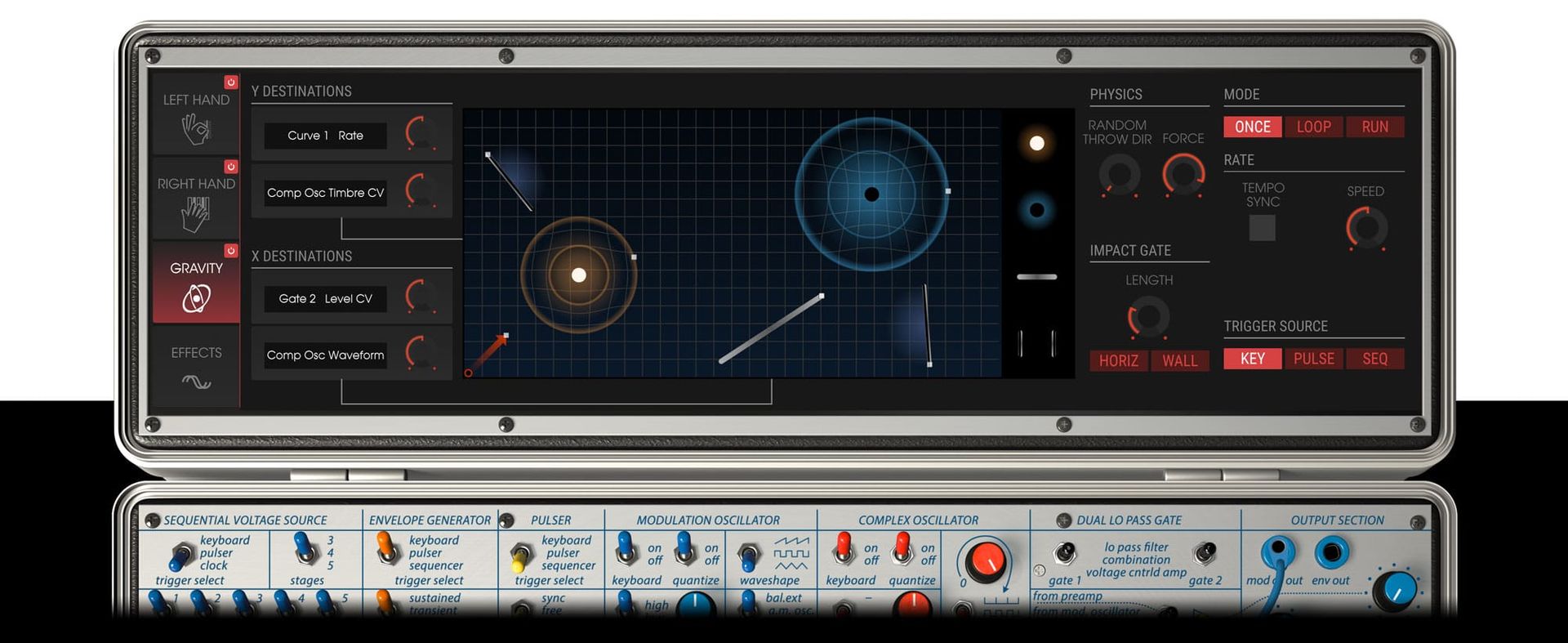
A complete electronic music system
Our enhancements to Buchla Easel V focus on keeping you in the creative zone. That includes built-in step sequencer and effects. You’re welcome.

Right Hand
This piano-roll style sequencer lets you define an exact length up to 32 steps. Want a 13-step sequence loop? No worries! Each step accommodates up to four-note polyphony. The intuitive graphic interface also allows you to easily drag notes to new positions and/or durations spanning multiple steps. In true Buchla style, each step can optionally be offset by the virtual control voltage you’ve programmed into any of the four Preset Voltage Sources you’ve set on the virtual keyboard. You control if and how your sequence loops, triggers and syncs to clock. Randomization and master gate complete a uniquely elegant sequencer.

Effects
Easel V comes complete with every standard effect you can think of, so the processing you need is completely integral to your sound design process and saved patches. Serial effects slots let you combine any two for complex designs like delaying a chorused signal to really fatten things up. You can even do things like combine two analog delays to add motion with even more interesting timing.
Everything you need to inspire endless experimentation is right inside Easel V.
Unlimited artistic expression
The Buchla Easel V authentically brings you the limitless potential a Buchla’s outside-the-box design coveted by synth aficionados. Covet no more.
If you’re already familiar with the original hardware, Buchla Easel V will blow you away with its authentic reproduction of the synth that helped start the entire West Coast school of thought in experimental analog synthesis. When you get a taste of the new sonic dimensions our modern additions open up, somebody might just have to drag you out of the studio from time to time. Even if all this sound power isn’t already an old friend, no worries. Some of the top sound designers in the industry have spent countless hours lovingly crafting nearly 300 presets to help launch the next chapter of your audio adventures.
SFX
A playground for experimentation, trial and error, and “happy accidents”, creating effects and soundscapes with Buchla Easel V come as naturally as breathing.
Sequences
Every part of Buchla Easel V wants to create something alive and vital, full of movement and energy. Sequences comes so naturally to this leftfield legend.
Leads
The ultimate synth test, and the quickest way to get to the heart of an instrument’s sound. The lead capabilities of the Buchla Easel V have to be heard to be believed
Whether you want instant satisfaction or endless creative journeys, Buchla Easel V is your ticket to exotic sounds in a whole different world of experimental synthesis.
Preset browser
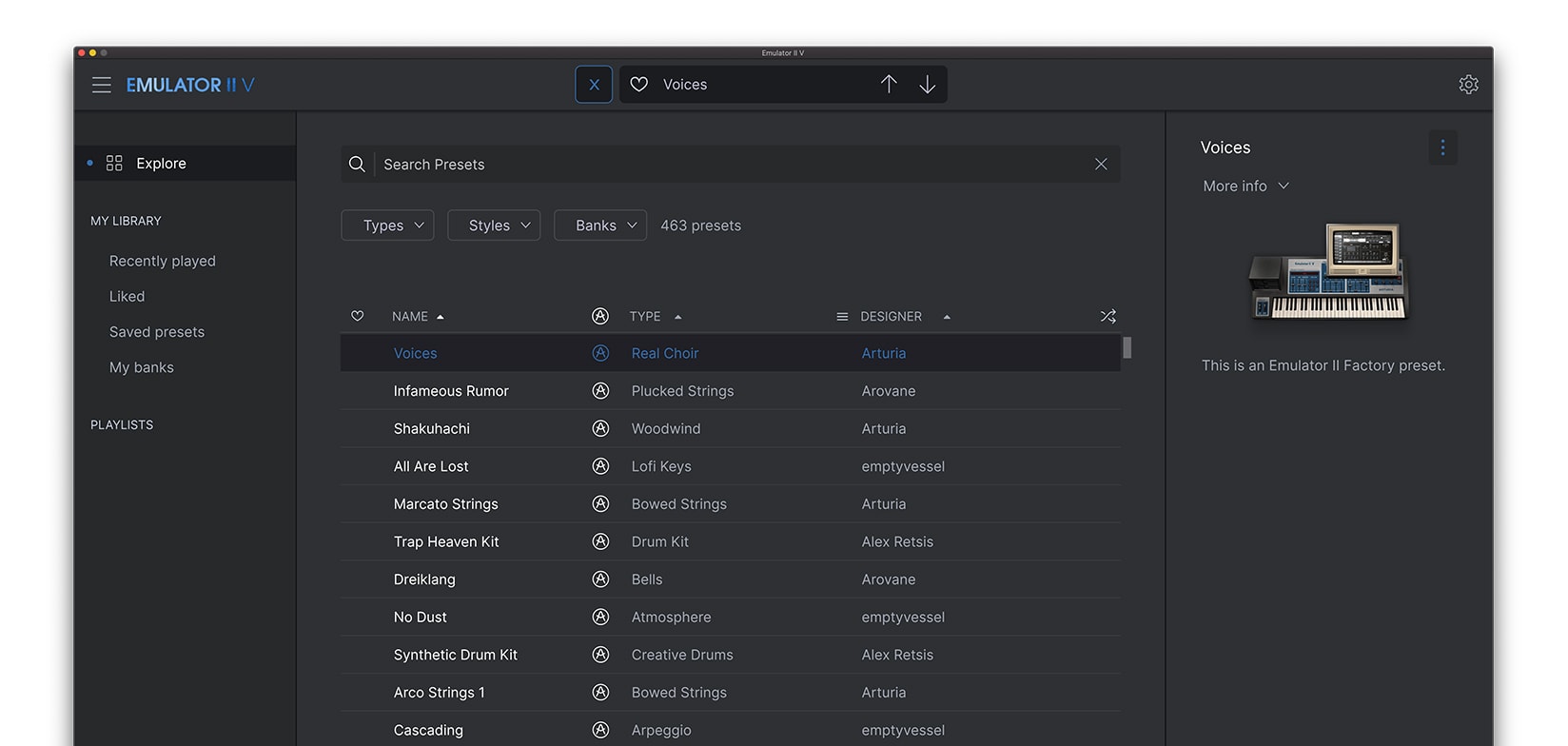
Our redesigned preset browser lets you quickly find just the sound you’re looking for.
Search by name or simply select the appropriate tags to dial in on the exact sonic character you’re looking for. You can mark and recall your own favorites, enter comments, and set up playlists. There’s never been a more intuitive way to manage your library of designer and personal presets.
Resizable GUI

The user interfaces for all your Arturia instruments are now resizable, making it easy to work with any High Resolution screen, UHD or Retina.
You can decide whether you want to fill the screen with awesome graphic reproductions of classic instrument goodness, scale the window down when you’re working in a DAW and screen real estate is at a premium, or even zoom for detailed work.
Platform specifications
 : Win 7+ PC: 4 GB RAM; 2 GHz CPU.
: Win 7+ PC: 4 GB RAM; 2 GHz CPU. 1GB free hard disk space
OpenGL 2.0 compatible GPU
 : 10.10+: 4 GB RAM; 2 GHz CPU.
: 10.10+: 4 GB RAM; 2 GHz CPU.1GB free hard disk space
OpenGL 2.0 compatible GPU
Required configuration
Works in Standalone, VST 2.4 (64-bit), VST 3 (64-bit), AAX (64 bits with PT 11), Audio Unit (64-bit).




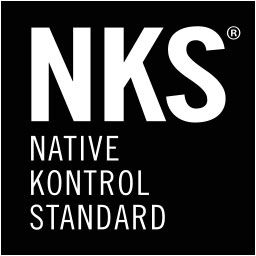
Protection
The software is protected by the Arturia Software Center.
| Variant | 1 |


















